How Big Are Royalties From Inventions?
Royalties from an invention are what most people are trying to achieve with their invention ideas. A licensing agreement is a contract between an inventor and a company. Typically the contract gives the company the right to manufacture and sell the invention. The inventor is referred to as the licensor of the invention. The licensor receives a small percentage on each product that is sold.
Percentages vary depending on many factors. The main factors include:
- How novel is the product
- How good is the patent protection
- How profitable is the product
The average royalty on a typical invention are 3-6% of the wholesale price of the product sold. The wholesale price is the price that the manufacturer sells the product to its customer. In most cases the customer is a retail store but the customer could also be to a distributor or a sale directly to an end user.
As an example a typical retailer such as Walmart or Target requires a 100% mark up on most products. If the product has a retail price of $10 the wholesale price would be $5. If the manufacturer sold the product to Walmart for $5 the inventor would make 5% of $5 or 25 cents per item sold.
Don't think this sounds like much? If Walmart sells two items per store per week in their 3000 stores the inventor would make $78,000 per year on that $10 item. Not bad for passive income from one chain of stores. Something else to keep in mind is that if your product is selling well in Walmart it could likely be sold in thousands of other stores in the US as well.
Licensing agreements can be great for an inventor if you have the right product and the right manufacturing partner. It sure is fun to receive a check every few months.
Return to Patent Licensing from Royalties
Return to Home Page from Royalties
Recent Articles
-
Don't Dare Underwear
Jun 19, 24 11:03 AM
I created a new concept of the boxer briefs with the pocket. They are specifically designed to carry a condom. Joining the fight against infectious diseases -
Rol-A-Flex: Platinum Edition
Apr 08, 24 11:24 AM
Hi My Name Is Malcolm Washington, I'm 19 Years Old And My Invention Is A New And Important Rol-A-Flex AB Belt Called Rol-A-Flex Platinum Edition, It's -
SENSE AWARE
Mar 26, 24 08:00 AM
Sense Aware represents the latest assistive technology project designed to improve safety and independence for the disabled. At its core is the Arduino

